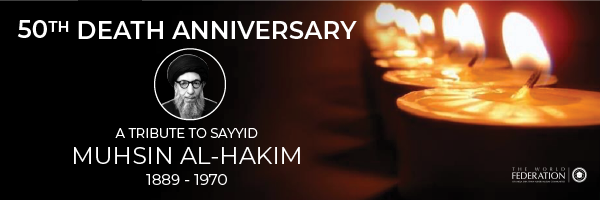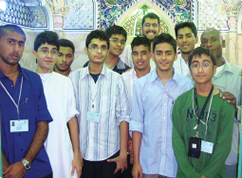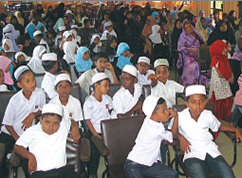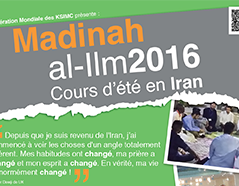Madinah & Bab is now accepting participants and mentors applications for their annual summer short courses for those aged 14-24yrs old. Find out everything you need to know about the best summer course in Iran here.

Today marks 50 years since the passing away of Grand Ayatullah Sayyid Muhsin al-Hakim.
After the demise of Agha Burujardi in 1961, Sayyid Muhsin al-Hakim became the leading Marja’ for most of the Shia world.

The Status of a Marja’ of Taqlid
An Infallible Imam (as) is the Divinely appointed guide for the people, resolving their religious, cultural, social, and political problems.
During the Minor Occultation (Ghaybat Sughra) of the Awaited Saviour (aj), the Shia would refer to the Four Deputies (Nuwwab Arba’ah), i.e. the intermediaries directly appointed by the Twelfth Imam (aj).
In the current period – i.e. the period of the Major Occultation (Ghaybat Kubra) – the duty of providing such essential guidance rests on the shoulders of the Marja’ of Taqlid, who are the best jurists in the top Shia learning centers.
Sayyid al-Hakim was one of these great Maraji’ of Taqlid. This remarkable scholar defended and spread the Shia faith despite the difficulties in Iraq at the time.
Some of his many accomplishments include increasing the number of seminary students from all over the world; educating the general public by building many public libraries and religious centers all over Iraq and abroad; establishing good relations with the Sunni brethren (esp. the Kurds in Iraq); defending political rights of the oppressed; and introducing the Shia identity to the world as a dynamic, rational, and progressive faith.

from L-R: Sayyed M Shahroodi, Sayyed Hakeem and Sayyed Khui (ar)
Ijtihad training
Sayyid al-Hakim was trained in the sciences of jurisprudence by highly eminent scholars, three of whom deserve special mention. Firstly, Akhund Muhammad Kazim Khurasani, whose text in the field of Usul al-Fiqh (Principles of Jurisprudence) is essential study for any aspiring Mujtahid. And secondly, Grand Ayatollahs Mirza Muhammad Husayn Na’ini and Agha Dhiya Iraqi, who trained a whole generation of great Mujtahids such as Sayyid Abul Qasim al-Khu’i.

Akhlaq training
Sayyid al-Hakim studied under several esteemed teachers of akhlaq. Their method of training was based on following all the rules of sharia; attaining the pleasure of God; developing love for God through regular dhikr, Qur’an recitation, and tawassul to the Ahl al-Bayt (as); and daily reflection on the nafs.
Such practices gradually lead to the illumination of the mind and heart to see God’s manifestations at all levels in creation. Furthermore, they enable a person to become a fully subservient agent of God, serving Him and His creation at all times.
Sayyid al-Hakim was known for being a humble servant to Allah. He would reflect on how to best serve the Creator and humanity in any given circumstance. He led a simple life and would first offer the people around him, even children, before he consumed anything.

Tabligh legacy
During his pilgrimage to hajj, Sayyid al-Hakim established the Hajj Mission of the Shia Marja’ to guide the lay Shia about their duties towards God. When he would go to Karbala, he would connect with the zuwwar of Imam Husayn (as), making himself available to them at all times. In this way, he was able to sit with people from all walks of life and guide them.
Sayyid al-Hakim played a major role in the upliftment of Shias in Africa and the Indian sub-continent. Many leaders kept close ties with Sayyid al-Hakim and sought his advice when working on various community projects. For example, the Bilal Muslim Mission was initiated by Sayyid al-Hakim when he reminded the visiting Africa Federation Chairman, Marhum Ebrahim Sheriff, in 1962, of the Khoja community’s tabligh duties toward the unreached indigenous people. In the same year, Africa Federation received an ijazah from Sayyid al-Hakim, which marked the beginning of the centralisation of Huqooq funds in East Africa.
On the recommendation of the Ayatullah, tabligh work started in 1963 through the efforts of people such as Maulana Sayyid Saeed Akhtar Rizvi. In 1967, Maulana Rizvi went to Mombasa and met with the Office Bearers of the Supreme Council; in that meeting, it was decided that two institutions – namely Bilal Muslim Mission of Kenya and Bilal Muslim Mission of Tanzania – would be established. Bilal Muslim Mission of Tanzania was registered in 1968 and Bilal Muslim Mission of Kenya in 1971.

Hawza legacy
Sayyid al-Hakim’s magnum opus in fiqh, Mustamsak al-‘Urwat al-Wuthqa (14 volumes), is still widely used today in the Hawza as it is a concise yet profound discussion on the demonstrative proofs for fiqhi rulings. His enduring legacy is inspired by the guidance of Imam al-Sadiq (as): “Whoever spreads knowledge will be rewarded for as long as learners benefit from it” (al-Kafi, vol 1, p35).
He pioneered the two volume fatwa book Minhaj al-Saliheen in simpler Arabic language accessible to the average muqallid. It includes all the major chapters of fiqh (including Amr bil Ma’roof in volume 1 and Sadaqa in volume 2) so subsequent maraji’ from Agha Khui to several current maraji’ including Agha Sistani have adapted it with their views.
Among the generation of students he trained are several current Maraji’: Their Eminences Sayyid Ali Husayni al-Sistani, Shaikh Wahid Khurasani, Sayyid Muhammad Sa’eed al-Hakim, and Shaikh Nasir Makarim Shirazi (may Allah protect all our Maraji’).
Through his directives, many libraries, mosques, and Hawzas were set up in Najaf, Baghdad, Basra, and other parts of Iraq and in other countries.

“Live with people such that when you die, they grieve over your demise”
Sayyid Muhsin al-Hakim passed away in Baghdad, Iraq on 27th of Rabi al-Awwal in 1390 AH (2nd June 1970) at the age of 84.
Huge crowds of people attended his funeral. He truly lived in the way that Imam Ali (as) advised in the tradition quoted above (Nahj al-Balagha, saying 10). As Imam al-Sadiq (as) has said, “Indeed, the death of a Faqih is an irreplaceable loss in Islam.” (al-Kafi, vol 1, p38). Grand Ayatullah Sayyid Muhsin Al-Hakim’s final resting place is in his library next to the Holy Shrine of Imam Ali (as).
We are indebted to towering figures such as Sayyid Muhsin al-Hakim. Let us remember him and all the past Maraji’ with a Sura Fateha.

Related News
Keep up to date with all the activities the Madinah and Babal-Ilm participants 2019 get on with!
The World Federation is pleased to introduce a series of videos to help us acquire closeness to Allah (swt). The first 5 videos will be an Introduction to Shahr Ramadan and for the rest of the Holy month we will focus on Akhlaq. Click here to watch Day 30.










